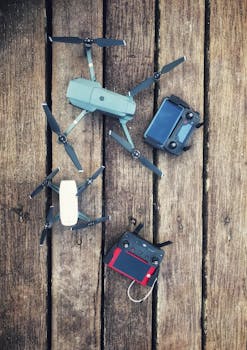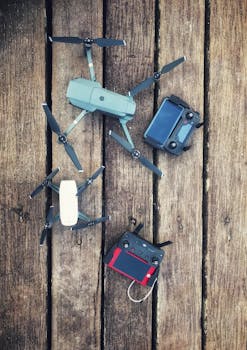The Basics of Drone Flight Controllers: A Beginner’s Guide
Drones have become increasingly popular in recent years, with their ability to capture stunning aerial footage and perform various tasks. However, behind every successful drone flight is a crucial component known as the flight controller. This small but powerful device is responsible for controlling the drone’s movement, stability, and overall performance. In this article, we will delve into the basics of drone flight controllers, how they work, and their importance in the world of drones.
First and foremost, it is essential to understand what a flight controller is and its purpose. A flight controller is a small electronic device that acts as the brain of a drone. It receives input from the pilot through a remote controller and sends signals to the drone’s motors, controlling its movement and stability. Think of it as the control tower of an airport, directing and coordinating the movements of the drones in the sky.
Now, let’s take a closer look at how a flight controller works. The flight controller consists of three main components: sensors, a microcontroller, and software. The sensors, such as gyroscopes, accelerometers, and barometers, provide information about the drone’s orientation, speed, and altitude. This data is then processed by the microcontroller, which is essentially the brain of the flight controller. The microcontroller uses the information from the sensors to make calculations and send commands to the drone’s motors, adjusting its speed and direction. The software acts as the interface between the pilot and the flight controller, allowing the pilot to input commands and receive feedback from the drone.
One of the most critical functions of a flight controller is to maintain the drone’s stability and keep it in the air. This is achieved through a process called PID (Proportional, Integral, Derivative) control. The flight controller constantly receives data from the sensors and compares it to the desired values set by the pilot. If there is a difference, the controller makes adjustments to the drone’s motors to bring it back to the desired state. This process happens hundreds of times per second, ensuring that the drone remains stable and responsive to the pilot’s commands.
Another essential aspect of a flight controller is its ability to control the drone’s flight modes. Flight modes determine how the drone responds to the pilot’s commands and can vary depending on the type of drone and its purpose. For example, a drone used for aerial photography may have a stable flight mode, where the drone maintains its position and altitude, allowing the pilot to focus on capturing footage. On the other hand, a racing drone may have an acrobatic flight mode, where the drone can perform flips and rolls in response to the pilot’s commands. The flight controller is responsible for switching between these modes and ensuring that the drone responds accordingly.
In addition to controlling the drone’s movement and flight modes, flight controllers also have other features that enhance the overall flying experience. These include GPS navigation, return-to-home function, and obstacle avoidance. GPS navigation allows the drone to follow a predetermined flight path, making it easier for the pilot to capture specific shots. The return-to-home function is a safety feature that brings the drone back to its take-off point in case of low battery or loss of signal. Obstacle avoidance uses sensors to detect and avoid any potential obstacles in the drone’s flight path, preventing collisions and crashes.
In conclusion, flight controllers are an essential component of any drone, responsible for its stability, movement, and overall performance. They work by receiving input from the pilot, processing data from sensors, and sending commands to the drone’s motors. With the advancement of technology, flight controllers continue to evolve, making drones more efficient, safe, and user-friendly. As a beginner, understanding the basics of flight controllers is crucial in mastering the art of flying a drone and unlocking its full potential.
Exploring the Different Types of Drone Flight Controllers

Drones have become increasingly popular in recent years, with their ability to capture stunning aerial footage and perform various tasks. However, behind every successful drone flight is a crucial component known as the flight controller. This small but powerful device is responsible for controlling the drone’s movement, stability, and overall performance. In this article, we will explore the different types of drone flight controllers and how they work.
Firstly, it is essential to understand that there are two main types of drone flight controllers: open-source and closed-source. Open-source controllers are those that allow users to modify and customize the software, while closed-source controllers have proprietary software that cannot be altered. Both types have their advantages and disadvantages, and it ultimately depends on the user’s needs and preferences.
One of the most popular open-source flight controllers is the ArduPilot. It is a versatile controller that can be used for various types of drones, from small quadcopters to large fixed-wing aircraft. The ArduPilot is equipped with sensors such as accelerometers, gyroscopes, and barometers, which allow it to gather data about the drone’s orientation, altitude, and speed. This information is then used to adjust the drone’s motors and control surfaces to maintain stability and perform maneuvers.
Another open-source flight controller is the Betaflight, which is specifically designed for racing drones. It has a fast response time and advanced features such as dynamic filtering and black box logging, making it a popular choice among drone racing enthusiasts. The Betaflight also has a user-friendly interface, making it easier for beginners to set up and customize their drones.
On the other hand, closed-source flight controllers, such as the DJI Naza-M, are known for their stability and reliability. These controllers are often used in commercial drones and are equipped with advanced features such as GPS, which allows for precise positioning and navigation. The DJI Naza-M also has a failsafe mode, which automatically lands the drone safely in case of a signal loss or low battery.
Apart from open-source and closed-source controllers, there are also different types of flight controllers based on their control algorithms. The most common ones are the PID (Proportional-Integral-Derivative) and the FOC (Field-Oriented Control). PID controllers use a set of mathematical equations to adjust the drone’s motors based on the difference between the desired and actual orientation. On the other hand, FOC controllers use a more advanced algorithm that takes into account the drone’s position, velocity, and acceleration to achieve smoother and more precise movements.
One of the most popular FOC controllers is the KISS (Keep It Super Simple) flight controller. It is known for its simplicity and reliability, making it a favorite among professional drone pilots. The KISS controller also has a built-in OSD (On-Screen Display) that provides real-time data such as battery voltage, flight time, and GPS coordinates.
In addition to these types of controllers, there are also specialized controllers designed for specific types of drones. For instance, the Pixhawk is a popular choice for autonomous drones, as it has advanced features such as waypoint navigation and mission planning. The DJI A3, on the other hand, is a flight controller specifically designed for heavy-lift drones used in industrial and agricultural applications.
In conclusion, drone flight controllers are essential components that play a crucial role in the performance and stability of a drone. Whether it is an open-source or closed-source controller, a PID or FOC controller, each type has its unique features and capabilities. As technology continues to advance, we can expect to see even more advanced and specialized flight controllers in the future.
Understanding the Inner Workings of Drone Flight Controllers: Sensors, Algorithms, and More
Drones have become increasingly popular in recent years, with their ability to capture stunning aerial footage and perform various tasks. However, behind their smooth and precise flight lies a complex system known as the flight controller. This small but powerful device is responsible for controlling the drone’s movement, stability, and overall performance. In this article, we will delve into the inner workings of drone flight controllers, exploring the sensors, algorithms, and other components that make them function.
At its core, a drone flight controller is a small computer that receives input from various sensors and uses algorithms to interpret and process that data. These sensors include accelerometers, gyroscopes, barometers, and GPS receivers. The accelerometers measure the drone’s acceleration and tilt, while the gyroscopes detect its orientation and rotation. The barometer measures air pressure, which is crucial for altitude control, and the GPS receiver provides location data.
The flight controller takes all this information and uses complex algorithms to determine the drone’s position, speed, and direction. It then sends signals to the motors, which adjust the propellers’ speed and direction to maintain stability and control the drone’s movement. This process happens hundreds of times per second, allowing the drone to fly smoothly and respond to the pilot’s commands.
One of the essential components of a flight controller is the Inertial Measurement Unit (IMU). This unit consists of the accelerometers and gyroscopes mentioned earlier, along with a magnetometer. The magnetometer measures the drone’s orientation relative to the Earth’s magnetic field, providing crucial information for navigation and stability. The IMU is responsible for keeping the drone level and stable, even in windy conditions or when performing complex maneuvers.
Another critical component of a flight controller is the processor. This is the brain of the controller, responsible for running the algorithms and making split-second decisions. The processor’s speed and power determine the drone’s overall performance, including its stability, responsiveness, and ability to handle different flight modes. As technology advances, flight controllers are becoming more powerful, allowing for more advanced features and capabilities.
In addition to the sensors and processor, flight controllers also have various other components that contribute to their functionality. These include the power distribution board, which distributes power from the battery to the motors and other components. The radio receiver, which receives signals from the remote controller, and the electronic speed controllers (ESCs), which control the motors’ speed and direction.
One of the most significant advancements in drone flight controllers is the integration of Artificial Intelligence (AI) and Machine Learning (ML) algorithms. These technologies allow the flight controller to learn and adapt to different flying conditions, making it more efficient and precise. For example, a drone equipped with AI and ML can adjust its flight path to avoid obstacles or maintain a stable position in windy conditions.
Flight controllers also have different flight modes, which allow the pilot to control the drone in various ways. These modes include manual mode, where the pilot has full control over the drone’s movement, and autonomous mode, where the drone can fly on its own using pre-programmed flight paths. Some flight controllers also have advanced features like return-to-home, where the drone can automatically fly back to its take-off point if it loses connection with the remote controller or runs low on battery.
In conclusion, drone flight controllers are complex systems that play a crucial role in the drone’s flight and performance. They use a combination of sensors, algorithms, and other components to interpret data and control the drone’s movement. As technology continues to advance, we can expect to see even more advanced flight controllers with enhanced capabilities and features. Understanding the inner workings of these controllers can help us appreciate the technology behind these flying machines and the incredible feats they can achieve.



